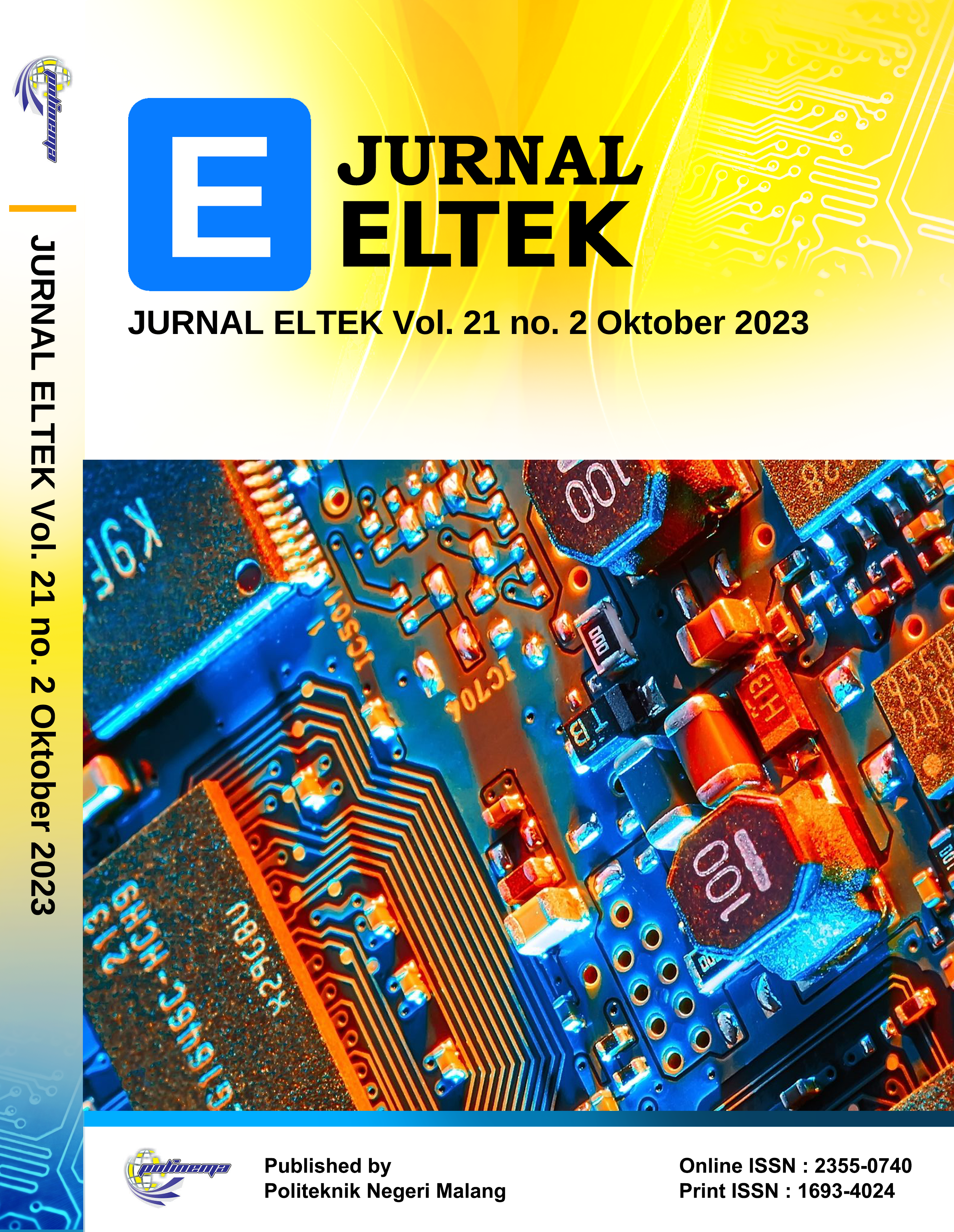Peningkatan efisiensi sistem PLTS melalui optimasi susunan array panel surya
DOI:
https://doi.org/10.33795/eltek.v21i2.3191Keywords:
Array, Mutual Shading, Optimasi, Panel Surya, TopologiAbstract
Letak geografis Indonesia sangat menguntungkan untuk pengembangan energi surya sebagai sumber energi listrik. Pembangkit listrik Tenaga Surya (PLTS) sangat cocok digunakan untuk mengatasi masalah pasokan listrik pada pulau-pulau di Indonesia. Beberapa faktor yang mempengaruhi daya luaran PLTS adalah iradiasi matahari, orientasi kemiringan modul surya, bayangan (shading), dan kenaikan temperatur. Bayangan merupakan masalah yang sangat penting karena dapat secara signifikan mempengaruhi efisiensi PLTS. Bayangan dapat ditimbulkan oleh pemasangan array modul surya dengan jarak yang tidak tepat (mutual shading) atau bangunan yang lebih tinggi disekitarnya. Penelitian ini bertujuan untuk meningkatkan efisiensi PLTS dengan meminimalisir efek mutual shading. Metode penelitian menggunakan eksperimental dengan mengumpulkan data primer berupa peak sun hour, iradiasi matahari, dan titik lokasi pengujian untuk mendapatkan potensi daya PLTS. Data sekunder merupakan data yang diperoleh dari pustaka terkait. Tahapan selanjutnya adalah pembuatan modul PLTS off grid dengan beberapa array modul surya sebagai peralatan uji. Pengambilan data dilakukan dengan variable bebas berupa jarak antar array, posisi array, iradiasi matahari, kondisi lingkungan, sedangkan variable terikat pada penelitian ini adalah nilai efisiensi PLTS. Dari hasil pengujian variasi sudut kemiringan panel surya dan variasi jarak antar array panel surya dapat disimpulkan bahwa topologi optimal pemasangan panel surya dengan ketinggian 10 cm adalah dengan sudut kemiringan 150 dan jarak antar array sebesar 20 cm.
ABSTRACT
Indonesia's geographical location is very favorable for the development of solar energy as a source of electrical energy. Solar power plants (PLTS) are very suitable to be used to overcome the problem of electricity supply on the islands in Indonesia. Several factors that affect the output power of PV mini-grid are solar irradiation, solar module tilt orientation, shading, and temperature rise. Shadow is a very important problem because it can significantly affect the efficiency of PV mini-grid. Shadows can be caused by installing an array of solar modules that are not properly spaced (mutual shading) or taller buildings in the vicinity. This study aims to increase the efficiency of PV mini-grid by minimizing the effect of mutual shading. The research method is experimental by collecting primary data in the form of peak sun hour, solar irradiation, and test location points to obtain the power potential of PLTS. Secondary data is data obtained from related libraries. The next stage is the manufacture of off-grid PLTS modules with several arrays of solar modules as test equipment. Data retrieval is carried out with independent variables in the form of distance between arrays, array position, solar irradiation, environmental conditions, while the dependent variable in this study is the value of PLTS efficiency. From the results of testing variations in the angle of inclination of solar panels and variations in the distance between arrays of solar panels, it can be concluded that the optimal topology for installing solar panels with a height of 10 cm is with a slope angle of 150 and the distance between arrays is 20 cm.
References
IESR (2021), “Beyond 207 Gigawatts : Unleashing Indonesia’s Solar Potential,” Inst. Essent. Serv. Reform, p. 38, 2021.
M. E. dan S. D. M. R. I. ESDM, “Peraturan Menteri Energi dan Sumber Daya Mineral Nomor 50 Tahun 2017 tentang Pemanfaatan Sumber Energi Terbarukan untuk Penyedia Tenaga Listrik.” Jakarta, 2017.
M. H. Radhi, “Design and Performance Analysis of Solar PV System Size 2 . 56 kWp,” 2019 4th Sci. Int. Conf. Najaf, pp. 70–73, 2019.
F. Bayrak and H. F. Oztop, “Effects of static and dynamic shading on thermodynamic and electrical performance for photovoltaic panels,” Appl. Therm. Eng., vol. 169, p. 114900, Mar. 2020.
H. P. Bambang, J. A. F. F. Muhammad, and F. H. Ilham, “Efisiensi Penggunaan Panel Surya Sebagai Sumber Energi Alternatif,” J. Emit., vol. 18, no. 1, pp. 10–14, 2014.
A. Rahardjo, Herlina, and H. Safruddin, “Optimalisasi Pemanfaatan Sel Surya Pada Bangunan Komersial Secara Terintegrasi Sebagai Bangunan Hemat Energi,” in Prosiding Seminar Nasional Sains dan Teknologi-II, 2009, pp. 56–65.
A. Dobos, T. Neises, and M. Wagner, “Advances in CSP Simulation Technology in the System Advisor Model,” Energy Procedia, vol. 49, pp. 2482–2489, 2014.
H. Assiddiq S and M. Bastomi, “Analisis Pengaruh Perubahan Temperatur Panel Terhadap Daya dan Efisiensi Keluaran Sel Surya Polycrystalline,” Din. J. Ilm. Tek. Mesin, vol. 11, no. 1, pp. 33–39, Dec. 2019.
I. Isdawimah, Ismujianto, L. Oktariza, A. Frederik, and N. Loc, “Investigation of Photovoltaic System Parameters Using LabView in Solar Irradiance Peak Condition,” in Journal of Physics: Conference Series, 2019, vol. 1364, p. 12065.
M. Qais and U. Khaled, “Evaluation of V–t characteristics caused by lightning strokes at different locations along transmission lines,” J. King Saud Univ. - Eng. Sci., vol. 30, no. 2, pp. 150–160, 2018.
X. Vallvé, A. Graillot, S. Gual, and H. Colin, “Micro storage and demand side management in distributed PV grid-connected installations,” in 2007 9th International Conference on Electrical Power Quality and Utilisation, EPQU, 2007.
X. Tong, M. Zhong, X. Zhang, J. Deng, and Z. Zhang, “Voltage regulation strategy of AC distribution network based on distributed PV grid-connected inverter,” J. Eng., vol. 2019, no. 16, pp. 2525–2528, 2019.
B. Ketola and A. Norris, “Degradation Mechanism Investigation of Extended Damp Heat Aged PV Modules,” in 26th European Photovoltaic Solar Energy Conference and Exhibition, 2011, pp. 3523–3528.
T. Kajisa, K. Mizuhara, and K. Hara, “Novel lighter weight crystalline silicon photovoltaic module using acrylic- film as a cover sheet,” Jpn. J. Appl. Phys., vol. 53, no. October 2015, 2014.
D. Topić, G. Knežević, and K. Fekete, “The mathematical model for finding an optimal PV system configuration for the given installation area providing a maximal lifetime profit,” Sol. Energy, vol. 144, pp. 750–757, Mar. 2017.
Downloads
Published
How to Cite
Issue
Section
License
Copyright (c) 2023 Muchlishah Muchlishah, Nuha Nadhiroh, Dimas Adi Nugroho, Ashwin Imaduddin

This work is licensed under a Creative Commons Attribution-ShareAlike 4.0 International License.







